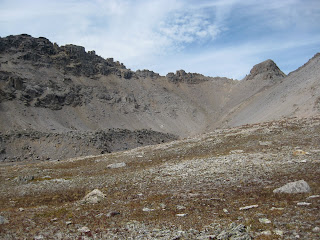This month's Accretionary Wedge is all about important geological experiences. I am not sure if this is the most important or just one that hit my brain at the same time I took some pictures, but the theme has existed ever since I took Geology 101.
I entered the University of Colorado with geology on my mind. I never took anything beyond Earth Science as a freshman in high school and now I was in a real university with a geology department. From the first day I found that there was a story to be found in the rocks. By the end of the first semester, I could start to tease out those stories myself...as long as they were simple stories.
My important geological experience was that with some simple tools I could interpret a rock, a outcrop, a road cut and even a mountain range. This idea shook me up. Here is something that happened a long time ago and with a few rules of physics I could construct a story about the origins of a landform...I was hooked.
This week, I have been working on some landscaping in the backyard. Part of the plan needed some small river cobbles and even though I hate the idea of paying for rocks, it sure was easier to get a truck to dump 3000 pounds (1361 kg)in the driveway. While moving the rocks, I started looking at them ( surprised?) Since the gravel pit is on the Uncompaghre River I knew the source area and I picked out examples of the different rock units I have played in over the years. There was a cobble from the Ancestral Rockies caught in the Cutler formation, some Ouray Limestone and as I would expect lots of examples of the San Juan Tuff. I washed some up and placed them in chronological order. What a geo-geek. But then it was back to work and only a few pictures were taken.
I now take this show on the road and invite all kinds of kids to try their hand at telling the story in the rocks.
The headwaters of the Uncompaghre River near Red Mountain Pass
 The 1361 kilogram pile in the driveway.
The 1361 kilogram pile in the driveway. A small collection before I had to get back to work.
A small collection before I had to get back to work.













